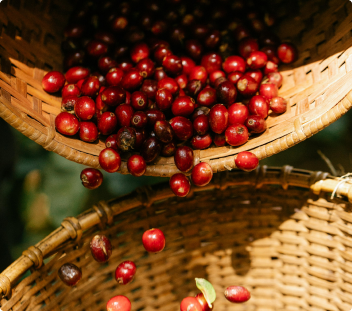
August 2024
How to reduce Scope 3 emissions from farming row crops?
Agriculture is a major source of emissions globally, with around 21% of GHG emissions coming from agriculture, forestry and other land use according to the IPCC. The main agricultural emissions consist of methane (mostly from livestock and manure management), nitrous oxide (from fertilizers), and carbon dioxide (from soil disturbance). On the other hand, agricultural soils can be a massive carbon sink when managed properly.
Like their name suggests, row crops are planted in rows for cultivation, and are usually annually planted and harvested by machines. Many different types of crops sit under the overall umbrella of row crops, including cereal grains like wheat, barley, and corn; legumes like soybeans; oilseeds like sunflower and canola; and many other staples like potatoes and sugar beets. While there is variation among crops, overall nitrogen fertilizer is the main source of emissions from row crops.
For companies involved in food processing and retail, emissions from farming row crops can constitute a considerable percentage of Scope 3 emissions. How can companies reduce the greenhouse gas impact of row crop farming, while enhancing the carbon sequestration capacity of the vast land area it uses? Read on to learn about the emission-reducing interventions you can implement, as well as what companies down the food value chain can do to report, claim and share the value of these interventions with their partners.
What interventions can help reduce emissions in row crop farming?
There are many practices that companies can invest in to reduce Scope 3 emissions from farming row crops. Many of these interventions align with what is increasingly known as regenerative agriculture, although the term doesn’t have a universally agreed definition. Key interventions relate to reducing emissions from soil disturbance, as well as introducing more organic matter into the soil. The main approaches we see companies take in row crop farming include no-till, cover cropping, and changing fertilization practices.
No-till or reduced tillage
Soil is a natural carbon sink, thanks to the vast amount of organic matter and microbes it contains. Most non-energy related carbon dioxide emissions from agriculture result from disturbing the soil organic matter, which can release some of this Soil Organic Carbon (SOC) into the atmosphere. Approaches like no-till or reduced tillage can help increase and maintain the carbon content of the soil by reducing disturbances that release carbon, enhancing the soil’s function as a carbon sink.
Cover cropping
Cover cropping can help increase Soil Organic Carbon by bringing new organic material to the fields. If left to decompose, cover crops can return carbon as well as nutrients like nitrogen back into the soil. This can also reduce the need for synthetic fertilizers. Cover crops have the added benefit of protecting fields from erosion in between harvests and adding another crop to rotations, enhancing the health of the soil and biodiversity.
Reducing fertilizer use and precision applications
Fertilizer application can lead to the formation of nitrous oxide, which is a potent greenhouse gas and accounts for more than half of the non-energy related emissions from agriculture.
More efficient fertilizer applications, such as reducing the amount of fertilizer as well as applying it at the plant level instead of broadcasting it into the field, can reduce nitrous oxide emissions considerably. There are innovative agricultural technologies that allow remote sensing to identify locations where fertilizer is most needed. Choosing the right timing is also important. Avoiding rainy periods can limit leeching into waterways and decrease nitrous oxide formation. Using legumes as cover crops and plowing them into the soil is another way to increase nitrogen while keeping synthetic fertilizers to a minimum.
Interventions aimed at reducing emissions can have multiple other ecosystem benefits beyond their carbon impacts. These include improved soil health and fertility, biodiversity, reduced erosion, and improvements to water quality. The holistic benefits can also increase the overall resilience of farming systems against climate change and improve yields.
How to credibly report climate impacts from row crop interventions?
To be able to credibly report and claim the climate impacts of an agricultural intervention in your value chain, your company should be able to demonstrate that the emission reductions are real and truly contributing to your organization’s climate targets.
Challenges like limited traceability and crop rotations increase the complexity of reporting emissions from agricultural interventions. SustainCERT verifies Scope 3 emission reductions and removals through our platform with in-built safeguards against double counting and over-counting. The resulting independent verification statement can feed into your company’s annual emissions reporting, aligned with GHG Protocol Scope 3 guidance.
Co-claim climate outcomes with Impact Units
Building collaboration with value chain partners can help decrease the needed resources to meet your company’s climate targets. Co-claiming climate outcomes with other companies active in the same value chain can incentivize co-investments into decarbonization. Effective supplier engagement is crucial to coordinate this process.
Through SustainCERT’s innovative impact tracking platform, companies along a value chain can claim the same impacts, as long as they are placed at different impact layers. Impact layers refer to value chain stages ranging from raw materials, mid-product manufacturers, end-product manufacturers, and finally wholesalers/retailers where applicable. Impact Units, representing emission reductions and removals, can be transferred in the SustainCERT platform from actors in one impact layer to another, allowing companies to co-claim climate mitigation outcomes while avoiding double counting.
The SustainCERT platform has built-in safeguards, which allow emission factors to be adjusted based on the physical amount of good sourced. For example, it helps calculate how the farm-level emission reductions in production of row crops such as soybean will translate to different derivative products like soybean meal or soybean oil, or further down to lecithin.
Addressing Scope 3 emissions in complex agricultural value chains such as those producing row crops can be a challenge. However, supporting the farmers in your value chain to implement regenerative agricultural practices like reduced tillage, cover cropping, and reduced fertilizer use, can speed up the decarbonization of your value chain. Improving soil health takes time, so getting started early is key to achieving success in Scope 3 emission reductions and removals.
This is part one of our series delving into value chain interventions in food and agriculture. Check out the other instalments to learn more about emission reductions in coffee, cacao, and dairy.
Looking to report and (co-)claim verified Scope 3 emission reductions?
Find out how SustainCERT’s value chain verification can help you.


